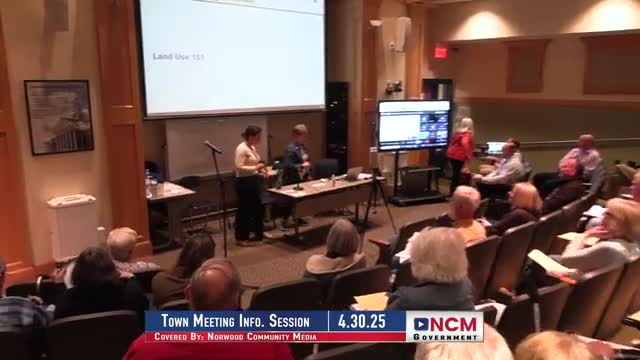Norwood outlines land-use roles, zoning rules and permit processes ahead of zoning articles
May 01, 2025 | Town of Norwood, Norfolk County, Massachusetts
This article was created by AI summarizing key points discussed. AI makes mistakes, so for full details and context, please refer to the video of the full meeting. Please report any errors so we can fix them. Report an error »

Sarah Dixon, the Town of Norwood director of community development, and Gary Pelletier, the building commissioner, provided an overview of how land use is regulated in town and described the permitting process for special permits, variances, site plan review and subdivision applications.
Dixon explained that the zoning bylaw divides Norwood into districts with a table of permitted uses and a separate table of dimensional requirements (setbacks, lot area, height). She said the bylaw cannot list every possible use, so planning staff and boards interpret and amend the table as new uses arise (examples given included urgent care clinics and body-art businesses).
Dixon described the sequence for zoning amendments: the planning board researches and drafts amendments, holds public hearings, asks the board of selectmen to place the article on the warrant, and presents a recommendation to town meeting. Most zoning amendments require a two-thirds vote at town meeting; certain housing-related changes may require only a simple majority under recent state law.
On relief from zoning standards, Dixon and Pelletier contrasted variances and special permits. Pelletier said variances are limited, applied to dimensional relief only and require the applicant to demonstrate unique hardship tied to the lot; special permits are discretionary and focus on whether a proposed use or change is "substantially more detrimental" to the neighborhood. Dixon noted that the planning and zoning boards typically hold public hearings where neighbors may speak.
Why it matters: several zoning articles are on the special town meeting warrant and at the annual meeting. Understanding board roles, the distinction between special permits and variances and the appeals process helps town meeting members evaluate proposed changes.
Details: Dixon said the updated FEMA floodplain maps trigger a required zoning update to the floodplain overlay district and the town must adopt the state's recommended regulatory language by early July to remain in the National Flood Insurance Program. She also summarized an article to clarify multifamily uses in the Boston Providence Highway (Route 1) district and a proposed change to the town's rules on nonconforming residential structures (raising the habitable-floor threshold that triggers board review from 25% to 75% for many additions).
Dixon explained that the zoning bylaw divides Norwood into districts with a table of permitted uses and a separate table of dimensional requirements (setbacks, lot area, height). She said the bylaw cannot list every possible use, so planning staff and boards interpret and amend the table as new uses arise (examples given included urgent care clinics and body-art businesses).
Dixon described the sequence for zoning amendments: the planning board researches and drafts amendments, holds public hearings, asks the board of selectmen to place the article on the warrant, and presents a recommendation to town meeting. Most zoning amendments require a two-thirds vote at town meeting; certain housing-related changes may require only a simple majority under recent state law.
On relief from zoning standards, Dixon and Pelletier contrasted variances and special permits. Pelletier said variances are limited, applied to dimensional relief only and require the applicant to demonstrate unique hardship tied to the lot; special permits are discretionary and focus on whether a proposed use or change is "substantially more detrimental" to the neighborhood. Dixon noted that the planning and zoning boards typically hold public hearings where neighbors may speak.
Why it matters: several zoning articles are on the special town meeting warrant and at the annual meeting. Understanding board roles, the distinction between special permits and variances and the appeals process helps town meeting members evaluate proposed changes.
Details: Dixon said the updated FEMA floodplain maps trigger a required zoning update to the floodplain overlay district and the town must adopt the state's recommended regulatory language by early July to remain in the National Flood Insurance Program. She also summarized an article to clarify multifamily uses in the Boston Providence Highway (Route 1) district and a proposed change to the town's rules on nonconforming residential structures (raising the habitable-floor threshold that triggers board review from 25% to 75% for many additions).
View full meeting
This article is based on a recent meeting—watch the full video and explore the complete transcript for deeper insights into the discussion.
View full meeting
